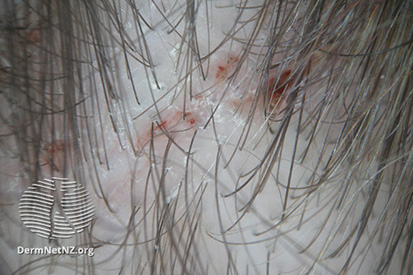Head Lice
Managing Head Lice: Symptoms and Treatment at Riva Dermatology
Head lice are tiny parasites that infest the scalp and hair, causing itching and discomfort. They spread through direct contact with infested individuals or sharing contaminated items like combs and hats. Head lice infestations require prompt treatment to prevent spreading to others.
Riva Dermatology offers effective treatments for head lice, including medicated shampoos, combing techniques, and guidance on environmental cleaning. Our dermatologists provide thorough evaluations and personalized treatment plans for all ages.
Get Rid of Head Lice Today
Combat head lice with expert treatment at Riva Dermatology. Schedule your appointment now to eliminate lice and regain comfort. Proudly serving Huntersville, Cornelius, Davidson, Mooresville, Denver, and nearby areas.
Examples of Head Lice





What are the Symptoms of Hair Lice?
- Discovering head lice typically begins with intense itching.
- You can identify tiny eggs resembling dandruff flakes in the hair before the onset of itching.
- To spot live eggs, closely examine the base of the hair, near the scalp, preferably under strong lighting conditions.
- Further signs may manifest as small, red bumps on the scalp, neck, or shoulders.
- Bumps may evolve into scaly patches or begin oozing.
Causes of Hair Lice
- Head lice is primarily transmitted from one person to another through direct physical contact.
- This easily transmissible infestation often occurs in close-knit environments, such as schools or households.
- The common mode of transmission involves lice crawling from the hair of an infected person to the hair of someone in close proximity.
How to Prevent Hair Lice
- Avoid Direct Head-to-Head Contact
- Educate About Personal Items: Stress the importance of not sharing personal items such as combs, brushes, hats, scarves, headphones, or any other items that come in contact with the hair.
- Regularly Clean Personal Items: Wash and clean personal items that come in contact with the hair, especially if they are shared among individuals.
- Use Protective Hairstyles: Keeping hair tied up or styled in a way that minimizes direct hair-to-hair contact.
- Routine Head Checks: Periodically check for signs of lice, such as itching, red bumps, or the presence of lice or eggs in the hair.
- Limit Personal Items in Shared Spaces: In communal spaces like schools or daycare centers, limit the sharing of personal items.
- Teach Proper Hygiene
- Be Informed: Stay informed about potential lice outbreaks in your community, especially if you have children in school.
Head Lice FAQs
Symptoms include itching of the scalp, visible nits (lice eggs) attached to hair shafts, and irritability due to discomfort.
Diagnosis involves finding live lice or nits on the scalp or hair strands. A dermatologist can perform a thorough examination to confirm an infestation.
Yes, head lice can affect people of all ages, especially children in close-contact environments like schools. Prompt treatment helps prevent spread to others.
Encourage good hygiene practices, avoid sharing personal items like combs or hats, and perform routine head checks to detect lice early.
How to Treat Hair Lice
Your dermatologists can assist with head lice by providing guidance on effective treatments and helping manage potential complications. In some cases, prescription medications may be necessary. Additionally, dermatologists can provide support and address any skin-related issues that may arise due to scratching or irritation caused by head lice.
Featured Products

CLn Healthy Scalp Shampoo
CLn Shampoo includes salicylic acid and sodium hypochlorite, and is designed for flakey scalps. It is an effective shampoo for normal-to-oily scalp and skin. Designed for scalp and skin prone to folliculitis, dermatitis, dandruff, beard dandruff and acne. 12 fl oz / 354 mL

Nutrafol Root Purifier Scalp Microbiome Shampoo
A physician-formulated, hydrating shampoo that visibly improves hair volume, strength, and texture in 2 weeks. Made with natural ingredients that deeply cleanse thinning hair without stripping the scalp.


